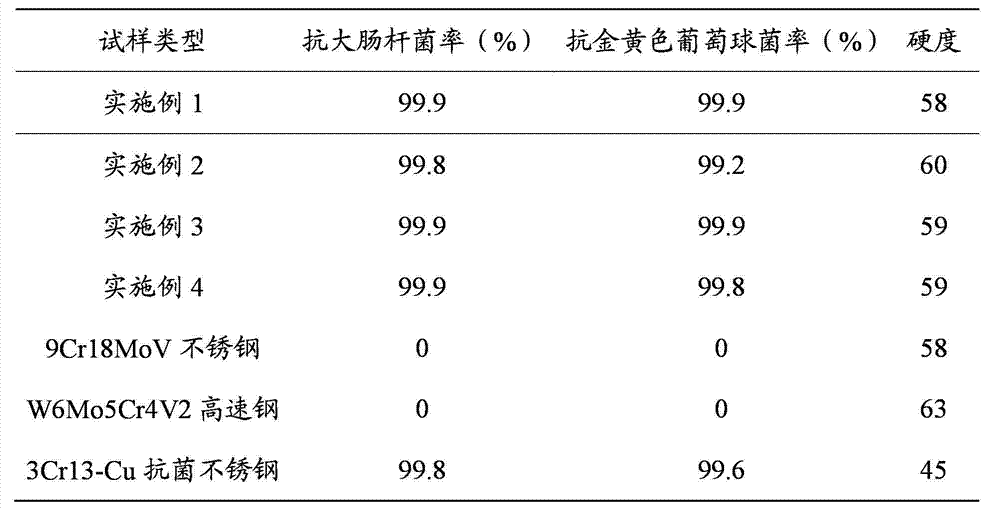High-hardness silver-bearing martensite antibacterial stainless steel
An antibacterial stainless steel and stainless steel technology, applied in the field of antibacterial stainless steel, can solve the problems of low hardness, low hardness and limited application of stainless steel, and achieve the effects of excellent antibacterial properties, improved hardness and wear resistance, great economic value and social value
- Summary
- Abstract
- Description
- Claims
- Application Information
AI Technical Summary
Problems solved by technology
Method used
Image
Examples
Embodiment 1
[0032] In terms of weight percentage, the chemical composition is: 0.8%C, 17%Cr, 3.0%Mo, 0.1%V, 1.5%W, 0.7%Al, 0.15%Ag, 1.0%RE, 0.035%S, 0.03%P, The stainless steel with 2.0% other impurity elements and the balance of Fe is smelted in a vacuum induction furnace, and then electroslag remelted to prepare metal ingots. The ingot was forged at 950°C to form a steel plate with a thickness of 20 mm, and then subjected to spheroidizing annealing at 840°C for 8 hours. Each steel plate was heated at 900° C. and hot-rolled to form a steel plate with a thickness of 5 mm. The steel plate is heated and kept at 700°C for 60 minutes, pickled with 3% dilute nitric acid, and then cold-rolled to produce a steel plate with a thickness of 2mm.
[0033] The produced steel plate is heated and kept at 950°C for 60 minutes in a nitrogen atmosphere, then quenched in oil, and then tempered at 400°C for 2 hours to obtain the product.
Embodiment 2
[0035]In terms of weight percentage, the chemical composition is: 1.2%C, 18%Cr, 1.0%Mo, 0.6%V, 1.0%W, 1.2%Al, 0.1%Ag, 0.1%RE, 0.025%S, 0.02%P, The stainless steel with 1.0% other impurity elements and the balance of Fe is smelted in an intermediate frequency induction furnace, and then electroslag remelted to prepare metal ingots. The ingot was forged at 1000°C into a steel plate with a thickness of 100mm, and then spheroidized at 900°C for 24h. Each steel plate was heated at 900° C. and hot-rolled to form a steel plate with a thickness of 5 mm. The steel plate is heated and kept at 900°C for 40 minutes, pickled with 3% dilute nitric acid, and then cold-rolled to produce a steel plate with a thickness of 0.5mm.
[0036] The produced steel plate is heated and kept at 1200°C for 30 minutes in an argon atmosphere, then quenched in oil, and then tempered at 600°C for 0.5h to obtain the product.
Embodiment 3
[0038] In terms of weight percentage, the chemical composition is: 1.0%C, 16%Cr, 2.0%Mo, 1.0%V, 3.0%W, 0.9%Al, 0.2%Ag, 0.6%RE, 0.005%S, 0.01%P, Stainless steel with 0.5% other impurity elements and the balance of Fe is smelted in a vacuum induction furnace, and then electroslag remelted to prepare metal ingots. The ingot was forged at 1200°C to form a steel plate with a thickness of 40mm, and then spheroidized at 820°C for 18h. Each steel plate was heated at 1100° C. and hot-rolled to form a steel plate with a thickness of 5 mm. The steel plate is heated and kept at 1000°C for 30 minutes, pickled with 3% dilute nitric acid, and then cold-rolled to produce a steel plate with a thickness of 1mm.
[0039] The produced steel plate is heated and kept at 1000°C for 40 minutes in a nitrogen atmosphere, then quenched in oil, and then tempered at 465°C for 1.5 hours to obtain the product.
PUM
| Property | Measurement | Unit |
|---|---|---|
| thickness | aaaaa | aaaaa |
| thickness | aaaaa | aaaaa |
Abstract
Description
Claims
Application Information
 Login to View More
Login to View More - R&D
- Intellectual Property
- Life Sciences
- Materials
- Tech Scout
- Unparalleled Data Quality
- Higher Quality Content
- 60% Fewer Hallucinations
Browse by: Latest US Patents, China's latest patents, Technical Efficacy Thesaurus, Application Domain, Technology Topic, Popular Technical Reports.
© 2025 PatSnap. All rights reserved.Legal|Privacy policy|Modern Slavery Act Transparency Statement|Sitemap|About US| Contact US: help@patsnap.com


